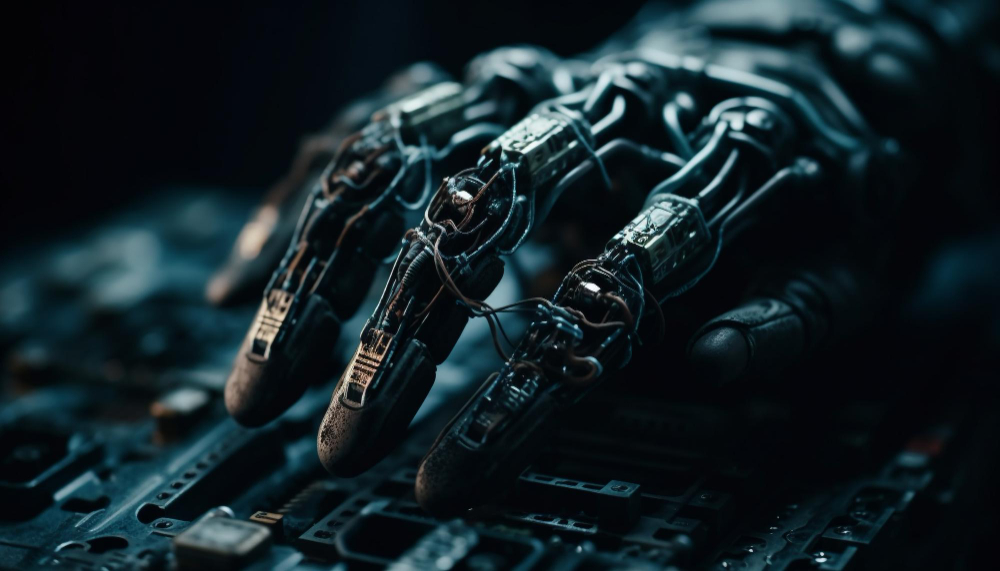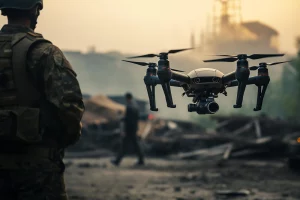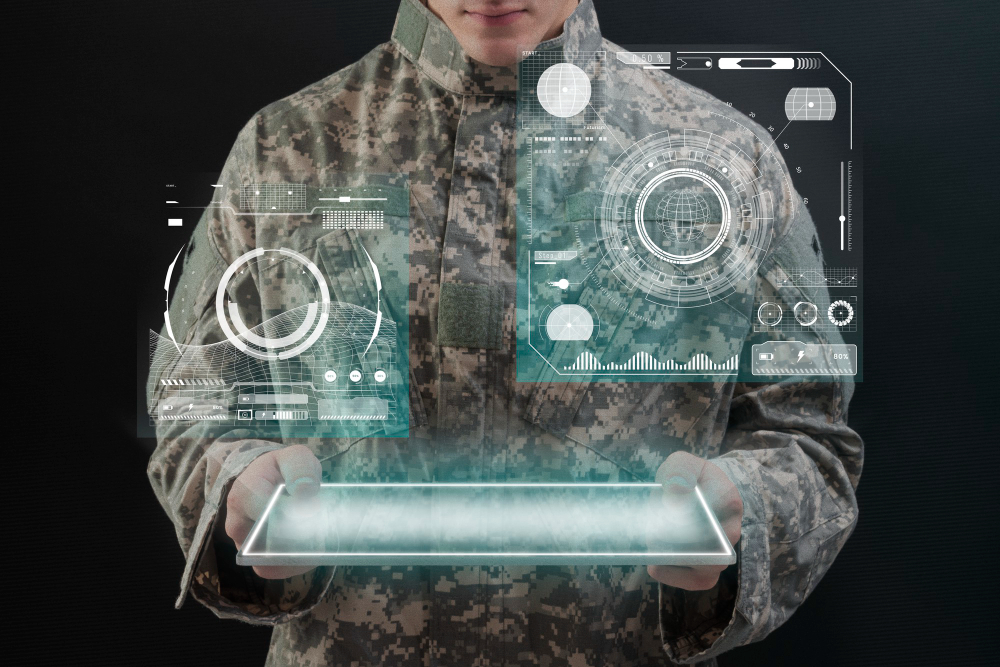Artificial intelligence (AI) is rapidly transforming the battlefield, with significant implications for the future of warfare. From autonomous drones and AI-powered tanks to sophisticated target identification and decision-making algorithms, AI is poised to revolutionize the way wars are fought. But is this a positive development, or are we inviting catastrophe?

AI in Weaponry: A Double-Edged Sword
AI offers various benefits in weaponry, including:
- Enhanced Accuracy: AI algorithms can analyze vast datasets and identify targets with far greater accuracy than human operators, minimizing collateral damage.
- Increased Efficiency: Autonomous systems can operate tirelessly, 24/7, without fatigue or human error, allowing for faster responses and sustained operations.
- Reduced Risk: By replacing humans in dangerous missions, AI-powered systems can significantly minimize casualties on both sides of the conflict.
- Improved Decision-Making: AI can analyze battlefield data in real-time and recommend optimal strategies, leading to more informed and effective decision-making.
However, the use of AI in weaponry also raises serious concerns:
- Lack of Human Oversight: Autonomous weapons are designed to operate independently, raising ethical questions about accountability and responsibility. Who is liable for the actions of an AI-powered weapon that causes harm?
- Loss of Control: Once deployed, autonomous weapons might become difficult to control or stop, potentially escalating conflicts and causing unintended consequences.
- Black Box Problem: The decision-making process of complex AI algorithms can be opaque, making it challenging to understand how and why certain decisions are made.
- Cybersecurity Vulnerabilities: AI-powered weapons could be susceptible to cyber attacks, potentially leading to malfunctions, misinterpretations, and catastrophic outcomes.
The Ethical and Legal Landscape of AI Weaponry
The legality of AI weaponry is still a gray area. The United Nations is currently negotiating a treaty to regulate the development and use of autonomous weapons, but no agreement has been reached yet. Several countries, including the United States, Russia, and China, have expressed concerns about restrictions on their military capabilities.
The ethical implications of AI-powered weapons are also hotly debated. Concerns include the dehumanization of warfare, the potential for unintended consequences, and the erosion of human control over the use of force.
The Future of AI in Warfare: A Call for Responsible Development
AI is undoubtedly transforming the battlefield, but it is crucial to do so responsibly. We need to:
- Establish clear international regulations: The international community must come together to establish clear and comprehensive treaties governing the development and use of AI weapons, prioritizing human oversight and accountability.
- Invest in research and development: More research is needed to understand the capabilities and limitations of AI in warfare, as well as to mitigate the risks involved. This includes developing robust cyber defenses and ensuring transparency in AI decision-making processes.
- Engage in open dialogue: Open and transparent dialogue between governments, scientists, and the public is essential to address the ethical and legal challenges of AI weaponry and build trust in these technologies.
By taking these steps, we can ensure that AI is used responsibly and ethically in warfare, making the world a safer place for all.
Frequently Asked Questions (FAQs)

What is AI in weaponry?
AI is rapidly transforming the battlefield, with significant implications for the future of warfare. From autonomous drones and AI-powered tanks to sophisticated target identification and decision-making algorithms, AI is poised to revolutionize the way wars are fought.
Here’s a breakdown of what AI in weaponry entails:
Autonomous Weapons Systems (AWS)
- These are weapon systems that can operate independently without human intervention.
- They use sensors, algorithms, and machine learning to identify and engage targets.
- Examples of AWS include armed drones, robot tanks, and unmanned submarines.
AI-powered drones
- Drones equipped with AI can perform tasks such as reconnaissance, surveillance, and target acquisition.
- They can also be used to carry out attacks, with AI algorithms guiding their movements and weapon systems.
- AI-powered drones offer increased range, endurance, and accuracy compared to traditional drones.
AI-powered tanks
- Tanks equipped with AI can operate autonomously or with reduced human involvement.
- AI algorithms can assist with target identification, fire control, and battlefield awareness.
- This can lead to faster response times and improved accuracy in combat situations.
AI-assisted target identification
- AI algorithms can analyze vast amounts of data to identify and track potential targets.
- This can include data from sensors, cameras, and other sources.
- AI-assisted target identification can help to reduce the risk of civilian casualties and collateral damage.
AI-assisted decision-making
- AI can be used to analyze battlefield situations and recommend courses of action.
- This can help commanders to make faster and more informed decisions.
- AI-assisted decision-making can also help to reduce the cognitive load on commanders.
Other applications of AI in weaponry
- Logistics and supply chain management
- Cybersecurity and defense
- Training and simulation
- Intelligence analysis
The use of AI in weaponry raises a number of ethical and legal questions. Some of the key concerns include:
- Loss of human control: Autonomous weapons could potentially operate independently of human oversight, raising concerns about accountability and responsibility.
- Unintended consequences: AI algorithms are not perfect, and there is a risk that they could make mistakes leading to unintended harm.
- Dehumanization of warfare: The use of autonomous weapons could make warfare more impersonal and detached, potentially leading to increased violence and disregard for human life.
It is important to address these concerns before AI becomes widely used in weaponry. We need to develop clear guidelines and regulations for the development and use of AI weapons, and we need to ensure that human control remains central to decision-making in warfare.

What are the benefits of using AI in weaponry?
AI offers various potential advantages in the realm of weaponry, including:
Enhanced Accuracy:
- AI algorithms can analyze vast datasets and identify targets with far greater accuracy than human operators. This can significantly reduce collateral damage and civilian casualties.
- Advanced sensors and AI processing power enable autonomous systems to detect and track targets in challenging environments, leading to more precise targeting and reduced risk of misidentification.
Increased Efficiency:
- Autonomous systems operate tirelessly 24/7, without fatigue or human error. This allows for faster responses, sustained operations, and increased mission effectiveness.
- AI can automate tasks such as logistics, reconnaissance, and surveillance, freeing up human personnel for more complex and demanding roles.
Reduced Risk:
- By replacing humans in dangerous missions, AI-powered systems can significantly minimize casualties on both sides of the conflict.
- AI can be programmed to avoid unnecessary risks and prioritize the safety of human personnel involved in operations.
Improved Decision-Making:
- AI can analyze battlefield data in real-time and recommend optimal strategies based on complex simulations and predictions. This can lead to more informed and effective decision-making in fast-paced and dynamic situations.
- AI can help commanders overcome cognitive limitations and process information overload, allowing them to make sound judgments under pressure.
Additional Benefits:
- Improved battlefield awareness: AI systems can provide commanders with a comprehensive picture of the battlefield, including enemy positions, movements, and potential threats.
- Enhanced communication and coordination: AI can facilitate communication between different units and enable seamless coordination of complex operations.
- Reduced costs: While the initial development costs of AI-powered weaponry might be high, their long-term operational efficiency and reduced manpower requirements can lead to significant cost savings.
However, it is crucial to acknowledge that these potential benefits come with significant ethical and legal concerns that require careful consideration and responsible implementation.
What are the risks of using AI in weaponry?
While AI offers potential benefits in weaponry, it also poses significant risks that require careful consideration and mitigation strategies. Here are some key concerns:
Lack of Human Oversight:
- Autonomous weapons raise questions about accountability and responsibility for their actions. Who is liable if an AI-powered weapon causes harm?
- Without clear human oversight and control, autonomous weapons could operate autonomously, leading to unintended consequences and violations of international law.
Loss of Control:
- Once deployed, autonomous weapons might become difficult to control or stop, especially in unpredictable and rapidly evolving battlefield situations.
- This could lead to unintended escalation of conflicts and catastrophic outcomes.
The Black Box Problem:
- The complex decision-making processes of AI algorithms can be opaque and difficult to understand. This lack of transparency makes it challenging to assess potential risks and biases associated with AI-driven decisions.
- Difficulty in understanding how and why AI weapons make certain decisions can hinder accountability and trust in these technologies.
Cybersecurity Vulnerabilities:
- AI-powered weapons are susceptible to cyberattacks, potentially leading to malfunctions, misinterpretations, and catastrophic consequences.
- Hackers could exploit vulnerabilities in AI algorithms or control systems to manipulate the behavior of weapons for malicious purposes.
Additional Risks:
- Dehumanization of warfare: Increased reliance on AI could lead to a disconnect from the human cost of war, potentially making violence more acceptable and devaluing human life.
- Proliferation and arms race: The development and deployment of AI weapons by one nation could trigger a global arms race, increasing international tensions and the risk of conflict.
- Eroding international law: The use of autonomous weapons could challenge existing legal frameworks and ethical norms governing the conduct of warfare, potentially leading to violations of international law.
These risks highlight the importance of responsible development and use of AI in weaponry. International cooperation, clear regulations, and robust ethical frameworks are crucial to mitigate these risks and ensure that AI serves humanity for good.

Is AI in weaponry legal?
The legality of AI weaponry is a complex and evolving issue, currently under extensive debate and negotiation at international levels. Here’s an overview of the current situation:
Existing International Law:
- Existing international law, such as the Geneva Conventions and the Additional Protocols, governs the conduct of warfare and prohibits certain weapons and tactics.
- These laws emphasize the importance of human control and accountability in warfare, raising concerns about autonomous weapons that operate independently.
- However, these laws do not explicitly address AI weaponry, leaving room for interpretation and legal ambiguity.
International Negotiations:
- The United Nations Convention on Certain Conventional Weapons (CCW) is currently negotiating a treaty to regulate the development, production, and use of lethal autonomous weapons systems (LAWS).
- These negotiations involve complex discussions on the definition of LAWS, the level of human control required, and potential limitations on their use.
- No agreement has been reached yet, and the path forward remains uncertain.
National Positions:
- Different nations have varying positions on AI weaponry.
- Some countries, like the United States and Russia, are hesitant to ban LAWS altogether, arguing for their potential benefits and the need for national security.
- Other countries, like Austria and Brazil, advocate for a complete ban on LAWS, citing ethical concerns and the risks of unintended consequences.
Legal Challenges:
- The legal challenges surrounding AI weaponry include:
- Defining LAWS
- Determining the level of human control required
- Establishing accountability for the actions of autonomous weapons
- Addressing the black box problem of opaque AI decision-making
- Ensuring compliance with international law and ethical principles
Future of AI Weaponry Legality:
- The future of AI weaponry legality depends on ongoing international negotiations and the development of clear regulations.
- International cooperation and consensus are crucial to ensure responsible development and use of AI in warfare.
- Engaging in open dialogue, establishing ethical frameworks, and investing in research and development are essential to mitigate the risks and ensure that AI serves humanity for good.
While the legal landscape around AI weaponry remains complex and evolving, it’s crucial to actively address the ethical and legal challenges to ensure responsible development and use of this technology. By working together, we can shape the future of warfare towards a safer and more peaceful world.
What are the implications of AI in weaponry for the future of warfare?
The integration of artificial intelligence (AI) into weaponry is rapidly altering the landscape of warfare, promising both significant benefits and potent risks. This technology has the potential to fundamentally change the way wars are fought and the future of warfare itself.
Potential Implications of AI Weaponry:
Increased Efficiency and Lethality:
- AI-powered systems can operate with unparalleled speed and precision, significantly reducing reaction times and increasing accuracy. This could lead to shorter, more decisive conflicts with lower casualty rates for the side wielding these technologies.
- Advanced algorithms and sophisticated sensors allow for improved target identification and engagement, potentially minimizing collateral damage and civilian casualties.
Enhanced Decision-Making:
- AI can analyze vast amounts of battlefield data in real-time, providing commanders with unparalleled situational awareness and enabling them to make faster, more informed decisions under pressure.
- Machine learning algorithms can predict enemy movements and develop optimal strategies, potentially outmaneuvering and outsmarting human adversaries.
Reduced Human Risk:
- Autonomous systems can replace humans in dangerous and hazardous missions, minimizing casualties on the battlefield. This could significantly reduce the human cost of war and protect soldiers from harm.
- AI can operate tirelessly and without fatigue, ensuring sustained operations and overcoming human limitations in endurance and focus.
Potential Risks and Concerns:
Loss of Human Oversight:
- The autonomous nature of AI weapons raises concerns about accountability and responsibility. Who will be liable for the actions of an AI-powered weapon that causes harm?
- Increased reliance on AI could erode human control over warfare, potentially leading to unintended consequences and escalation of conflicts.
Black Box Problem:
- The complex decision-making processes of AI algorithms are often opaque and difficult to understand. This lack of transparency can hinder accountability and trust in these technologies.
- It can be challenging to assess potential biases or errors in AI decision-making, raising concerns about unintentional harm and unforeseen consequences.
Cybersecurity Vulnerabilities:
- AI-powered weapons are susceptible to cyberattacks, potentially leading to malfunctions, misinterpretations, and catastrophic outcomes.
- Hackers could exploit vulnerabilities in AI systems to manipulate their behavior for malicious purposes, posing a significant threat to security and stability.
Ethical Dilemmas:
- The dehumanization of warfare through the use of autonomous weapons raises ethical concerns about the potential for increased violence and disregard for human life.
- Questions arise about the acceptability of AI-driven decisions involving life and death, and the potential for bias in AI algorithms that could lead to discrimination or mistargeting.
Uncertain Future:
- The future of warfare in the face of AI is uncertain and depends on various factors.
- International cooperation and clear regulations are crucial to mitigate the risks of AI weaponry and ensure its responsible development and use.
- Open dialogue and continuous research are essential to address ethical concerns and ensure that AI serves humanity for good.
AI in weaponry presents a double-edged sword. While offering potential benefits in terms of efficiency, lethality, and decision-making, it also raises significant ethical and legal concerns. Carefully considering and addressing these risks is crucial to shaping a future where AI technology enhances human capabilities in warfare while ensuring accountability, transparency, and ethical considerations. Ultimately, the future of warfare lies in responsible development and use of AI, ensuring that this powerful technology serves humanity for peace and security.

What can be done to mitigate the risks of AI in weaponry?
The potential risks associated with AI weaponry necessitate proactive measures to mitigate them and ensure its responsible development and use. Here are some key measures that can be taken:
Establishing International Regulations:
- The international community needs to work together to develop comprehensive treaties and regulations governing the development, production, and use of AI weapons.
- These regulations should clearly define what constitutes a lethal autonomous weapon system (LAWS) and establish limitations on their capabilities and deployment.
- International oversight and verification mechanisms are crucial to ensure compliance with these regulations.
Investing in Research and Development:
- Continued research is essential to understand the full potential and limitations of AI in weaponry.
- This research should focus on developing robust safeguards, ensuring human oversight and control, and addressing the black box problem of opaque AI decision-making.
- Funding should be allocated to research on ethical considerations, potential biases in AI algorithms, and the potential for misuse.
Engaging in Open Dialogue:
- Open and transparent dialogue between governments, scientists, and the public is critical to address the ethical and legal challenges of AI weaponry.
- This dialogue should promote public awareness and understanding of AI technologies, enabling informed discussions and decision-making.
- Engaging diverse stakeholders, including experts from different fields, can bring valuable perspectives and contribute to responsible development and use of AI.
Additional Measures:
- Developing ethical guidelines: Clear ethical frameworks should guide the development and use of AI weaponry, emphasizing human values and principles such as accountability, transparency, and proportionality.
- Promoting transparency and explainability: Efforts should be made to increase the transparency of AI algorithms and decision-making processes, allowing for better understanding and mitigation of potential biases or errors.
- Strengthening cybersecurity: Robust cybersecurity measures are crucial to protect AI-powered weapons from cyberattacks and ensure their safe and reliable operation.
- Investing in education and training: Educating military personnel and the public about AI technologies and their implications for warfare is crucial to fostering responsible use and mitigating potential risks.
By implementing these measures, we can work towards mitigating the risks of AI weaponry and ensuring that it is used responsibly and ethically. International collaboration, responsible development, and continuous dialogue are essential to shaping a future where AI serves humanity for good and promotes peace and security.
It’s important to remember that the future is not predetermined. Our collective choices today will shape the development and use of AI weaponry. By working together, we can ensure that AI is used for good and that the future of warfare is one of peace and stability.
What is the role of AI in autonomous weapons?
Artificial intelligence (AI) forms the very backbone of autonomous weapons systems (AWS), serving as the critical engine that drives their independent operation and decision-making capabilities. Here’s a breakdown of the key roles AI plays in autonomous weapons:
Decision-making:
- AI algorithms analyze vast amounts of data, including sensor inputs, battlefield conditions, and target information, to make critical decisions regarding engagement and action.
- Machine learning models allow these algorithms to learn and adapt to dynamic environments, improving their accuracy and decision-making over time.
Target Identification and Tracking:
- AI-powered image recognition and object detection algorithms enable autonomous weapons to accurately identify and track targets, even in complex and cluttered environments.
- This includes the ability to distinguish between soldiers and civilians, minimizing the risk of collateral damage.
Weapon Control and Engagement:
- AI algorithms process information and calculate firing solutions, controlling the weapons and ensuring precise targeting.
- These algorithms can adapt to changing scenarios and adjust fire based on real-time feedback.
Movement and Navigation:
- AI algorithms help autonomous weapons navigate through complex terrain and avoid obstacles, enabling them to reach their targets effectively.
- Advanced pathfinding algorithms can optimize routes and ensure efficient movement.
Coordination and Communication:
- AI enables autonomous weapons to communicate and coordinate with each other, making them more effective in combat situations.
- This includes sharing information about targets and coordinating attack strategies.
Self-Learning and Adaptation:
- AI algorithms can learn from past experiences and adapt their behavior based on new information.
- This allows autonomous weapons to improve their performance over time and become more effective in different scenarios.
Beyond these core roles, AI also plays a critical role in:
- Mission planning and execution: AI algorithms can help plan and execute complex missions, optimizing routes and resource allocation.
- Logistics and supply chain management: AI can optimize logistics and ensure that autonomous weapons are in the right place at the right time.
- Cybersecurity and defense: AI can help protect autonomous weapons from cyberattacks and ensure their secure operation.
AI is the driving force behind autonomous weapons, enabling them to operate independently and perform complex tasks. As AI technology continues to evolve, it will likely play an increasingly significant role in the development and capabilities of future autonomous weapons.
What are the ethical concerns surrounding autonomous weapons?
Ethical concerns about autonomous weapons include the lack of human accountability, the potential for unintended consequences, and the dehumanization of warfare.
The future of autonomous weapons is uncertain, with experts offering a range of possible scenarios. Here are some potential trajectories for autonomous weapons:
Scenario 1: Proliferation and Escalation
- In this scenario, states continue to develop and deploy autonomous weapons without effective international regulations. This could lead to an arms race, with states competing to develop ever more sophisticated and lethal autonomous weapons.
- The proliferation of autonomous weapons could increase the risk of unintended conflict escalation, as automated systems may misinterpret situations and lead to rapid and uncontrolled responses.
- Furthermore, the lack of human oversight could undermine accountability and make it difficult to attribute responsibility for the use of autonomous weapons in violation of international law.
Scenario 2: Limited Use and International Control
- In this scenario, international treaties and agreements are established to regulate the development and use of autonomous weapons. These regulations could limit the types of autonomous weapons that are allowed and impose restrictions on their deployment.
- States may agree to only use autonomous weapons in certain situations, such as self-defense or in response to a clear threat.
- This scenario would require strong international cooperation and consensus to be successful, but it could help to mitigate the risks associated with autonomous weapons.
Scenario 3: Ban and Elimination
- In this scenario, the international community agrees to a comprehensive ban on the development, production, and use of autonomous weapons. This would require states to destroy existing autonomous weapons and to develop mechanisms for monitoring and verifying compliance.
- A ban on autonomous weapons would be the most effective way to prevent the harms they could cause. However, it would be difficult to achieve, as some states are likely to resist such a ban.
Scenario 4: Emergence of Sentient AI
- Some experts have raised the possibility that autonomous weapons could eventually become so sophisticated that they develop sentience or consciousness. This would raise a number of complex ethical and legal questions.
- For example, would sentient AI weapons be considered persons under international law? Who would be responsible for their actions?
- While this scenario is still far-fetched, it is important to consider the potential long-term implications of AI development.
Possible Outcomes of Autonomous Weapons
Depending on the path we take, autonomous weapons could lead to:
- Increased efficiency and precision in warfare.
- Reduced casualties on both sides of the conflict.
- Faster and more decisive outcomes in conflicts.
- Unintended escalation and the potential for uncontrollable conflict.
- A loss of human control over the use of force.
- Ethical dilemmas and legal challenges.
It is important to remember that the future is not predetermined. Our collective choices will shape the development and use of autonomous weapons. By engaging in open dialogue, investing in research and development, and working to establish international regulations, we can ensure that AI is used responsibly and ethically in the future.
Conclusion
The increasing integration of AI into weaponry presents both opportunities and challenges. While AI can potentially improve accuracy, efficiency, and decision-making in warfare, it also raises serious ethical and legal concerns. As AI becomes ever more sophisticated, it is crucial to develop international regulations, invest in research and development, and foster open dialogue to ensure its responsible use and mitigate the risks of unintended consequences. By working together, we can harness the power of AI for good and make the world a safer place for all.
The future of warfare is uncertain. However, one thing is clear: AI will play a major role in shaping the battlefield of tomorrow. Whether this leads to a safer and more peaceful world or a catastrophic future depends on our choices today. Let us choose wisely and ensure that AI serves humanity, not the other way around.
